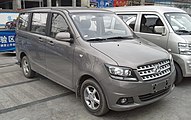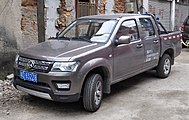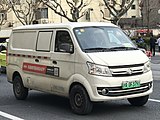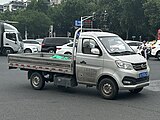Changan Automobile
 | |||||||
| Company type | State-owned | ||||||
|---|---|---|---|---|---|---|---|
| ISIN | CNE000000R36 | ||||||
| Industry | Automotive | ||||||
| Founded | 1862 | ||||||
| Headquarters | , China | ||||||
Area served | Worldwide | ||||||
| Products | Motor vehicles | ||||||
Production output | 1,900,000 units (2021) [1] | ||||||
| Parent | China South Industries Group | ||||||
| Subsidiaries | Changan UK R&D Centre Ltd. | ||||||
| Chinese name | |||||||
| Simplified Chinese | 重庆长安汽车股份有限公司 | ||||||
| Traditional Chinese | 重慶長安汽車股份有限公司 | ||||||
| Literal meaning | Chongqing Chang'an Automobile Joint-stock Limited Corporation | ||||||
| |||||||
| Website | globalchangan.com | ||||||
Chang'an Automobile Co., Ltd.[2] is a Chinese state-owned automobile manufacturer headquartered in Jiangbei, Chongqing.[3] Founded in 1862, it is China's oldest automobile maker.[4][5] It is currently the smallest of the "Big Four" state-owned car manufacturers of China, namely: SAIC Motor, FAW Group, Dongfeng Motor Corporation, and Changan Automobile, with car sales of 5.37 million, 3.50 million, 3.28 million and 2.30 million in 2021 respectively.[6]
The company produces and sells vehicles under its own branding, such as Changan, Oshan, Kaicene, as well as under foreign-branded joint ventures such as Changan-Ford and Changan-Mazda. In 2021, domestic branded cars took over 76% of sales (1.75m, 1.2m passenger vehicles).[7]
Its principal activity is the production of passenger cars, microvans, commercial vans and light trucks.[8]
It is China's second most popular car brand, with 1.4 million Changan cars sold in 2016.[9] A subsidiary of Changan, Chongqing Changan Automobile Company (SZSE: 000625), is listed on the Shenzhen Stock Exchange (but is also state controlled).[3]
History
Changan's early origins can be traced back to 1862 when Li Hongzhang set up a military supply factory, the Shanghai Foreign Gun Bureau.[10] It is China's oldest automobile maker.[5] In 1937, during the Second Sino-Japanese War, the factory was moved to Chongqing when Shanghai was invaded and bombed.[11]
In 1959 a predecessor entity, Chongqing Chang'an Arsenal, under contract to the government, began auto manufacturing and built Changjiang Type 46 vehicle which was the first production vehicle of China.[12] Changan introduced minicar by licensing from Suzuki.[13]
In 2009, Changan acquired two smaller domestic automakers, Hafei and Changhe.[14] In 2013, Changhe was transferred to Jiangxi provincial government for restructuring, and later became a majority-owned subsidiary of another Chinese automaker BAIC Group.[15]
As of 2010, China Weaponry Equipment is the parent company of this state-owned automaker,[16] and that year Chang'an became the fourth most-productive car manufacturer in the Chinese automobile industry by selling 2.38 million units.[17]
The company also released a new logo for its consumer offerings in 2010 while commercial production retains the former red-arch brand.[8]
Although it only allowed the company to achieve fourth place among domestic automakers in terms of production, Changan made over 2 million whole vehicles in 2011.[18]
In 2012, it was reported that 72% of production was dedicated to passenger vehicles,[19] but this count likely conflates private offerings and microvans, tiny commercial trucks and vans that are popular in China.
In November 2012, Changan Ford Mazda Automobile was divided into two new joint venture companies: Changan Ford and Changan Mazda.[20]
Changan plans to ending production of vehicles powered solely by internal-combustion engines by 2025, as the automaker will be selling only hybrid vehicles and all-electric vehicles from 2025 as a result due to the climate change, air pollution issues in the China and stringent emissions regulations. The company stated that this is because Government of China announced that it has passed legislation that will ban new ICE-powered vehicles by the mid-2030s, due to high air pollution and due to China's reiterated commitment in the United Nations Paris Agreement as the automaker wants remain compliant with the government's automotive emission standards. The automaker is joining Volvo Cars, Jaguar Land Rover, Hongqi, BYD Auto, Lotus Cars, and several other automakers in planning on ceasing production of ICE-powered vehicles in the coming years.[21]
Changan said it plans to launch 21 electric cars in the 2021–2025 period, increasing its sales of that kind of vehicles to over 1 million units.[22]
Brands and products
Changan produces and markets vehicles primarily under 5 brands:[23]
- Changan Auto for SUVs and passenger cars
- Changan Qiyuan for entry premium electric vehicles line under Changan brand
- Deepal (Shenlan) for electric vehicles
- Avatr for premium electric vehicles, jointly invested by Chang'an and CATL
- Oshan (frequently transliterated as Auchan, Ossan, or Oushan) for mid-level SUVs and MPVs
- Kaicene for the commercial vehicles, light trucks, and MPVs
Changan Auto
Current models
Sedan
- Changan Lumin
- Changan BenBen
- Changan Eado EV
- Changan Eado DT
- Changan Eado Plus
- Changan Yida
- Changan Raeton Plus
- Changan UNI-V
SUV
- Changan CS15
- Changan CS35 Plus
- Changan CS55 Plus
- Changan CS75 Plus/CS75
- Changan CS85
- Changan CS95
- Changan UNI-K
- Changan UNI-T
Pickup truck
Discontinued models
Sedan/hatchback
- Changan Raeton (2012-2019), mid-size sedan
- Changan Alsvin V3 (2012-2017), subcompact sedan
- Changan Alsvin/ Alsivin V5/ Alsvin II (2009-2023), subcompact sedan
- Changan Alsvin V7/ Eado DT (2014-2022), subcompact sedan
- Changan Eado XT/XT RS (2012-2020), compact hatchback
- Changan Z-Shine/ CX30 Hatchback/Sedan (2008-2012), subcompact car
- Changan E30 EV (2005–2012), electric compact sedan
SUV
- Changan CS35 (2012-2022)
MPV
- Changan CX20 (2010–2016), MPV
- Chana Eulove (2013-2015), MPV
- Changan Joice (2007-2009), MPV
- Changan Linmax, MPV
- Chana CM6, microvan
- Chana CM7 (2003-2015), microvan
- Chana CM8 (2003-2015), microvan
- Changan SC6320G/Changan SC1011 (1990–1999), pickup/van
Chang'an Qiyuan
Chang'an Qiyuan (长安启源) is the entry level EV line under the Chang'an brand, launched in 2023. Models initially include the A05 compact sedan, the A06 compact sedan, and the A07 midsize sedan. The A06 is a rebadged Changan UNI-V with restyled front and rear ends.[24] The A05 is a rebadged Changan Yida with restyled front and rear ends.[25]
- Changan Qiyuan A07 (to commence), mid-size sedan[26]
- Changan Qiyuan A06 (to commence), compact sedan
- Changan Qiyuan A05 (to commence), subcompact sedan
- Changan Qiyuan Q05 (to commence), compact SUV
Deepal (Shenlan)
Deepal (Chinese name Shenlan) is EV brand owned by Changan Automobile. The company was originally named Chongqing Changan New Energy Automobile Technology founded in 2018 and became an independent brand since 2023.
-
Deepal SL03
-
Deepal S7
Oshan
Oshan (Chinese: 欧尚) is a passenger car brand under Changan Automobile. It was originally known as the Changan Commercial Vehicles, the division which focus on micro vans and light trucks. The brand was renamed to Oshan in April 2017 and began to produce passenger vehicles since.
Changan Kaicene
Current models
- Raesor (Ruixing) ES30
- Raesor (Ruixing) S50
- Raesor (Ruixing) S50T
- Raesor (Ruixing) M60 / Raesor (Ruixing) EM60
- Raesor (Ruixing) M70
- Raesor (Ruixing) M80 (Changan G10)/ Raesor (Ruixing) EM80
- Raesor (Ruixing) M90
- Star 3
- Star 5
- Star Truck/ Star truck EV
- Star Truck C-type/ Star truck L1
- Star 9/ Star 9 EV
- Shenji T10/ Shenji T10 EV
- Shenji T20
- Shenji T30
- F30
- F70
- A800
- A600 (Originally Changan Oushang)
- Honor (欧诺)
-
Chana Ruixing S50V
-
Chana Ruixing S50T
-
Chana Ruixing M90
-
Chana Ruixing M80
-
Chana Ruixing M70
-
Chana Honor
-
Kaicene F30
-
Kaicene F70
-
Kaicene Star Truck
-
Kaicene Shenqi T30
Former models
- Ruiline
- Shenqi T20 / Q20
- Shenji F50
- Kaicene Zunxing
- Chana Star
- Chana Star 2
- Chana Star 7 (Formerly Taurustar)
- Chana Star 9 (Formerly Chana Star 4500)
- Chana Star S460
- Changan Zunxing
Sales
| Year | Total[a] | Changan[b] | Oshan | Deepal |
|---|---|---|---|---|
| 2010 | 1,316,557 | - | - | |
| 2011 | 987,991 | - | - | |
| 2012 | 950,568 | - | - | |
| 2013 | 990,556 | - | - | |
| 2014 | 1,126,011 | - | - | |
| 2015 | 1,270,154 | - | - | |
| 2016 | 1,382,917 | - | - | |
| 2017 | 1,327,168 | 339,910 | - | |
| 2018 | 1,139,540 | 192,745 | - | |
| 2019 | 1,060,676 | 153,258 | - | |
| 2020 | 1,306,169 | 861,750 | 113,820 | - |
| 2021 | 1,557,282 | 998,921 | 194,381 | - |
| 2022 | 1,874,569 | 1,125,048 | 222,030 | 33,354 |
Joint ventures
Like most major Chinese automakers, Changan partners with Western and Japanese companies to produce and sell the products of these foreign firms in China. It also partners with other companies within China to augment manufacturer capacity and share development costs.
Changan currently participates in the following joint ventures:
Avatr Technology
Avatr Technology is a premium EV brand Changan joint-ventured with battery provider CATL and multiple Chinese domestic foundations, technology supported by Huawei.[29]
Ford (2001–present)

In 2001, Chang'an Ford was formed[31] and initially built Ford-branded passenger vehicles from complete knock down kits.[12]
Making Chinese-market versions of Ford consumer offerings,[8] its 2010 dealer network was thought to include many showrooms in second- and third-tier Chinese cities[citation needed] such as Chongqing.[32] So-called second- and third-tier cities are large and medium-sized cities not among the top four in terms of population and contribution to GDP.[33]
Changan Mazda (2012–present)
Changan Kuayue
Chongqing Kuayue Automobile is a co-operative venture between Changan and Chongqing Kuayue Group specializing in commercial vehicle production.[34]
The group builds commercial vehicles for Changan primarily under the Kuayue and Kaicene brands.
Kuayue commercial vehicles rebranded as Mamut in former Soviet countries.
Current models
- Kuayue D5
- Kuayue T3
- Kuayue Chana V3 / V3 Electric
- Kuayue Chana V5
- Kuayue X1
- Kuayue X3
- Kuayue X5[35]
- Kuayue Kuayuexing V3/V5/V7
-
Kuayue Kuayuexing V3
-
Kuayue Kuayuexing V5 EV
-
Kuayue V5
-
Kuayue Kuayuewang X1
-
Kuayue Kuayuewang X5
Former models
-
Kuayue Xinbao mini
-
Kuayue Xinbao
-
Kuayue Xinbao T3
-
Kuayue Kuayuewang X5
-
Kuayue Xinbao V5
-
Kuayue Xunlong
Jiangling Investment and Jiangling Motor Holding
Jiangling Motor Holding Co. Ltd. (simplified Chinese: 江西江铃控股有限公司; traditional Chinese: 江西江鈴控股有限公司; pinyin: Jiāngxī Jiānglíng Kònggǔ Yǒuxiàn Gōngsī), also known by the initialism JMH, was a joint venture established in October 2004 and controlled equally by Changan and JMCG. To create Jiangling Motor Holding Changan invested money and in exchange JMCG transferred its Jiangling Motors Corporation (JMC) equity to the venture. Jiangling Motor Holding was the largest shareholder of JMC,[36] with a 41.03% stake as of March 2018.[37] JMH also owned the Landwind marque.[36][38]
In April 2019, it was announced that JMCG and Changan planned to split JMH into two separate companies: one keeping the same name and other tentatively called Jiangling Investment. Jiangling Investment would hold the 41.03% JMC stake and some liabilities and would still be equally owned by Changan and JMCG. The new JMH would own the rest of the former JMH assets (including Landwind)[39][40] and it would issue 100% more shares to be sold to investors, leaving JMCG and Changan with a 25% stake each.[40] Jiangling Investment was formally established in May 2019, completing the split of the former JMH.[41] In June 2019, it was announced that the investor for the new JMH was the car manufacturer Aiways. Aiways acquired a 50% of the new JMH with the aim of securing production permits for new energy vehicles.[42][43]
Former
Changan PSA (2010-2020)

Changan and the French car manufacturer PSA Peugeot Citroën agreed in 2010 to set up a 50/50 passenger car and light commercial vehicle-making joint venture.[44] Named CAPSA, it was the PSA Group's second joint venture company in China, after Dongfeng Peugeot-Citroën Automobile, and its first with Chang'an.[45] Centering on a newly built production base in Shenzhen, it was estimated that initial production capacity for the project will be 200,000 units/year.[46] Manufacturing commenced in 2014, with China specific Citroën DS models; the DS 5LS first and then the DS 6WR.[47] The venture was dissolved in 2020.
Changan Suzuki (1983-2021)

Technical and commercial cooperation with Suzuki Motors, beginning in 1983, saw Changan assembling inexpensive commercial trucks (originally the Suzuki Carry ST90 as the Chang'an SC112[48]) under license into the 2000s.[49] The two companies formed Chongqing Chang'an Suzuki Automobile Co in 1993,[31] which built licensed versions of the Suzuki Alto, Suzuki Cultus, and more recently the Swift.
In parallel with its Suzuki joint venture, Changan also continued to build small trucks and vans for commercial use based on the 1999 Suzuki Carry license, but independently developed vehicles are quickly replacing them.[49] These small cars carry the Changan brand name although Suzuki technology is used in their design and manufacture.
On 4 September 2018, Suzuki transferred its 50 percent stake in Changan Suzuki to Chang'an Automobile Group, ending 25 years of joint venture. Under the plan, Chang'an would continue to make and sell Suzuki-branded cars in China under license.
In 2021, Changan Suzuki was renamed to Chongqing Lingyao Automobile.[50]
Production and research facilities
Domestic
Changan has four major production bases (in the City of Chongqing, Hebei province, Jiangsu province, and Jiangxi province),[citation needed] eleven automobile production bases, and two engine production bases in mainland China[51] for a more-current total of 21 vehicle-making bases including newer sites in Anhui province, Guangdong province, Heilongjiang province, Shandong province, and Shanxi province.[citation needed]
Anhui
A planned 300,000 units/year capacity mini-vehicle production base in Hefei, Anhui province, should see completion in 2011.[citation needed] Production capacity figures may consider engines and vehicles as discrete.
Beijing
An existing R&D center in Beijing[52] will soon be joined by a passenger car production base in Fangshan District, Beijing, which will become operational in 2012.[citation needed]
Chongqing
Chang'an has numerous sites in the city of Chongqing. A Chang'an-Ford plant and another, planned Chang'an-Ford plant (which may produce engines[53]) are joined by a Chongqing-based R&D center[52] and an industrial park in Yubei, Chongqing.[citation needed]
Hebei
An industrial park in Hebei province may continue to be Chang'an controlled.[citation needed]
Heilongjiang
A Harbin, Heilongjiang province, R&D center, is now a Chang'an asset.[52] It may have been owned by Hafei prior.
Jiangsu
A Chang'an-Ford plant and an industrial park[citation needed] in Nanjing, Jiangsu province, may comprise Chang'an operations in this province.
Jiangxi
A planned Chang'an commercial vehicle production base in Nanchang, capital of Jiangxi province, will produce JMC and Ford-branded vehicles[53] and join an R&D center[52] as a second facility in this province. The latter facility may be a former Changhe asset.
Shanghai
Chang'an has an R&D center in this coastal city.[52]
International
The company maintains four factories in international markets and several overseas R&D centers. Chang'an had an assembly plant in Poteau, Oklahoma, piecing together products sold under the Tiger Truck brand from 2007 to 2010.[54] The Changan CS35 is built in Lipetsk region of Russia since 2016.[55] Also Changan vans and pickup trucks were assembled at Ganja Auto Plant in Ganja city, Azerbaijan in 2005.
Karachi
Changan has built a production facility in Karachi Pakistan. A joint venture with Master Motors with an investment of US$100 million. This plant will make right hand drive passenger vehicles for Pakistan as well other right hand drive markets. First Made in Pakistan unit of Changan rolled out on 2 May 2019. With a manufacturing capacity of 30,000 cars per year this facility will be Changan's first to produce right hand drive cars.
R&D centers
Chang'an has over 7,000 engineers and researcher working in R&D facilities in Chongqing, Beijing, Shanghai and Harbin,[10] Turin, Italy,[52] and Yokohama, Japan.[52] It set up two more in 2011. These are located in Birmingham (originally was set up in Nottingham), United Kingdom, and Detroit, United States.[56] The Detroit center opened in early 2011, and its office was moved to Plymouth 2015.[57][58]
Notes
References
- ^ "Autoline Daily". Retrieved 3 March 2022.
- ^ Chana > Contact Us > Dealer Application Chana Official Site (Web Archive)
- ^ a b China rolls out own hybrid car reuters.com, Sat December 15, 2007 1:44am EST
- ^ "About Us - Changan International".
- ^ a b Narasimhan, T. E. (2016-07-09). "China's Changan revs up for India entry". www.business-standard.com. Retrieved 2016-07-09.
- ^ "2021全年汽车销量出炉,上汽卫冕,三家民营车企挤入前十_腾讯新闻".
- ^ "2021 Sales Report-News - Changan International".
- ^ a b c China's Changan unveils new car logo in brand drive reuters.com, Sun October 31, 2010 11:55am EDT
- ^ Moss, Trefor (2017-10-19). "Major Chinese Car Maker Plans Electric-Only Future". Wall Street Journal. ISSN 0099-9660. Retrieved 2021-03-06.
- ^ a b TABETA, SHUNSUKE (8 Feb 2017). "Changan Auto sells 3m cars in record year". The Nikkei Asian Review. Retrieved 20 January 2018.
- ^ Xu, Xiao; Han, TianYang (3 Dec 2012). "Colorful history, ambitious goals for Chang'an Auto". The China Daily.
- ^ a b "Changan About us". Retrieved 20 January 2018.
- ^ Gallagher, Kelly Sims (2006). China Shifts Gears: Automakers, Oil, Pollution, and Development. The MIT Press. pp. 88. ISBN 9780262072700.
- ^ For purchase of Hafei, see New policy to encourage China's carmaker consolidation xinhuanet.com, 2010-02-22 10:27:20
- For purchase of Changhe, see Year in review: A memorable 2009 saw China's ascent to top of global vehicle market chinadaily.com.cn, 2010-04-24
- ^ "BAIC takes majority stake in Changhe Auto". China Daily. 26 November 2013.
- ^ Milestone merger reshapes Suzuki chinadaily.com.cn, 2010-03-29 09:26
- ^ China Car Market 101: Who Makes All Those 18 Million Cars? thetruthaboutcars.com, January 19, 2011
- ^ 2011年前十家乘用车生产企业销量排名. China Association of Automobile Manufacturers (CAAM). 2012-01-20. Archived from the original on 2012-08-20.
- ^ "2012年12月分车型前十家生产企业销量排名". China Association of Automobile Manufacturers (CAAM). 14 January 2013. Archived from the original on January 15, 2013. Retrieved January 15, 2013.
- ^ "Restructure of Changan Ford Mazda Automobile Approved". Mazda. 30 November 2012. Retrieved 3 March 2014.
- ^ "China's Changan steers toward electric future". Nikkei Asia. Retrieved 2021-03-06.
- ^ "Changan Plans to Launch All-Electric Vehicles in 5 Years". Lahore Herald. September 18, 2021.
- ^ "Changan to be rebranded as Kaicene, Berjaya Auto Asia announces". sg.news.yahoo.com. Retrieved 2021-09-17.
- ^ "搭载插混系统 长安启源A06申报图曝光". 15 June 2023.
- ^ "全新设计风格 长安启源A05申报图曝光". 15 June 2023.
- ^ "长安启源". www.changan.com.cn. Retrieved 2023-09-12.
- ^ "HOME | Automotive Industry Portal MarkLines | Portal". www.marklines.com. Retrieved 2022-12-05.
- ^ "2022年12月汽车销量排行榜_盖世汽车社区". i.gasgoo.com. Retrieved 2023-03-07.
- ^ "Huawei, Changan and CATL Launch New Avatr Car Brand in China". 19 November 2021.
- ^ "【图】将于三季度首发 阿维塔12申报信息曝光_汽车之家". www.autohome.com.cn. Retrieved 2023-07-14.
- ^ a b "Chana History". Chana Official Site. Archived from the original on 2010-08-12. Retrieved 6 March 2023.
- ^ Naughton, K. (Apr 21, 2013). "Automakers Go West in China to Thin Margins, Fat Growth". bloomberg.com. Bloomberg LP. Retrieved 22 September 2013.
- ^ Mullich, Joe. "China's "Second-Tier" Cities Take Off". The Wall Street Journal. Dow Jones and Company, Inc. Retrieved June 4, 2012.
- ^ "Commercial vehicle-KUAYUE GROUP". www.kuayuegroup.com. Retrieved 2021-09-17.
- ^ "VEHICLES-1". Chongqing Changan Kuayue Automobile Co., Ltd. Retrieved 2021-09-17.
- ^ a b 江铃控股详细资料 [Jiangling Holding details]. auto.ifeng.com (in Chinese). Retrieved 1 February 2019.
- ^ "Jiangling Motors Corporation, Ltd. 2017 Annual Report" (PDF). JMC. pp. 27, 29. Retrieved 1 February 2019 – via Sohu.
- ^ "Landwind". JMCG. Retrieved 1 February 2019.
- ^ Hu, Xinyu (3 April 2019). 江铃汽车控股股东拟变更为江铃投资 [Jiangling Motors' controlling shareholder is planned to be changed to Jiangling Investment]. jrj.com.cn (in Chinese). Retrieved 3 April 2019.
- ^ a b Liu, Yang; Zhen, Zhenyu (3 April 2019). 长安汽车拟为江铃控股引入战略投资者 [Changan Automobile intends to introduce strategic investors for Jiangling Holding]. finance.sina.cn (in Chinese). Retrieved 3 April 2019.
- ^ Jian, Jianru (30 May 2019). Zhang, Bei (ed.). 江铃汽车和长安汽车共同成立投资公司 注册资本10亿元 [Jiangling Group and Changan Automobile jointly established an investment company with a registered capital of 1 billion yuan]. nbd.com.cn (in Chinese). Retrieved 7 June 2019.
- ^ Li, Xing (5 June 2019). 爱驰汽车购入江铃控股50%股权 首款量产车已开始生产 [Aiways acquired a 50% equity in Jiangling Holdings. The first production car has started production]. finance.sina.cn (in Chinese). Retrieved 7 June 2019.
- ^ Xing, Lei (6 June 2019). "AIWAYS Acquires 50 Percent Stake In Jiangling Holding For Nearly ¥1.75 Billion". China Automotive Review. Retrieved 7 June 2019. [permanent dead link]
- ^ China Chang’an Automobile Group and PSA in Joint Venture discussion Archived 2010-12-09 at the Wayback Machine PSA Peugeot Citroën Official Site, 5/06/2010
- ^ CAPSA – Chang’an-PSA’s new joint venture company Archived 2013-11-19 at the Wayback Machine chinacartimes.com, June 15, 2011
- ^ For Shenzhen production base, see "About CAPSA: Changan PSA Automobiles Co., Ltd Profile". capsa.com.cn. Changan Automobiles Co Ltd. Archived from the original on 22 December 2013. Retrieved 27 September 2013.
- ^ "PSA launches DS compact crossover in China". Automotive News Europe. 10 October 2014. Retrieved 19 November 2014.
- ^ Mastrostefano, Raffaele, ed. (1990). Quattroruote: Tutte le Auto del Mondo 1990 (in Italian). Milano: Editoriale Domus S.p.A. p. 103.
- ^ a b World of Cars 2006·2007. Warsaw, Poland: Media Connection Sp. z o.o. 2006. pp. 226–227.
- ^ "Changan Suzuki changes name to Lingyao Automobile". autonews.gasgoo.com. Retrieved 2021-09-15.
- ^ "Company Portrait". CHANA International Corporation. Archived from the original on 21 May 2010. Retrieved 21 September 2013.
- ^ a b c d e f g "Changan Auto Group opens three new R&D centers". Gasgoo Automotive News. Gasgoo.com. April 20, 2010. Retrieved 21 September 2013.
- ^ a b Ford posts 40% sales increase in 2010 Archived 2011-04-14 at the Wayback Machine chinacartimes.com, January 7, 2011
- ^ Simpson, Susan (October 8, 2010). "Tiger Truck closing Poteau plant". NewsOK.
- ^ "Production Of Changan CS35 Started In Lipetsk Region". Wroom.ru. Archived from the original on 2016-10-01. Retrieved 2016-10-01.
- ^ For Birmingham center, see "Chinese car maker to create 200 new jobs in Nottingham". East Midlands Development Agency. Archived from the original on 2011-07-18. Retrieved 2011-02-02.
- For Detroit center, see "China's Changan Auto to set up Detroit R&D centre -Xinhua". reuters.com. Thomson Reuters. 2010-06-30. Archived from the original on 2013-09-26. Retrieved 21 September 2013.
- ^ "Changan UK R&D Center website". Changan UK R&D Center, Inc. n.d. Archived from the original on 2018-08-17. Retrieved 1 November 2018.
- ^ "Changan USA R&D Center Set Up in Detroit". changanus.com. Changan US R&D Center, Inc. 18 January 2011. Archived from the original on 13 December 2013. Retrieved 27 September 2013.
External links
- Official website
 (in Chinese)
(in Chinese) - Global Changan
- China’s Changan and Master Motor to set up auto plant in Karachi article at The Express Tribune
- Companies in the SZSE 100 Index
- Changan Automobile
- Companies in the CSI 100 Index
- Companies listed on the Shenzhen Stock Exchange
- Vehicle manufacturing companies established in 1862
- Car manufacturers of China
- Electric vehicle manufacturers of China
- Government-owned companies of China
- Chinese brands
- Companies based in Chongqing
- Truck manufacturers of China
- Chinese companies established in 1862


























































